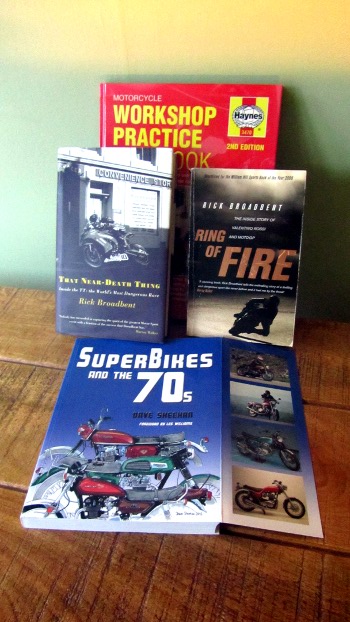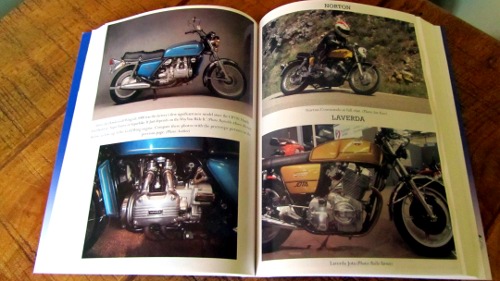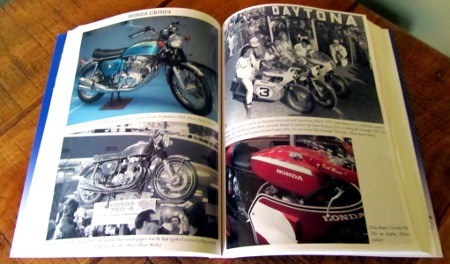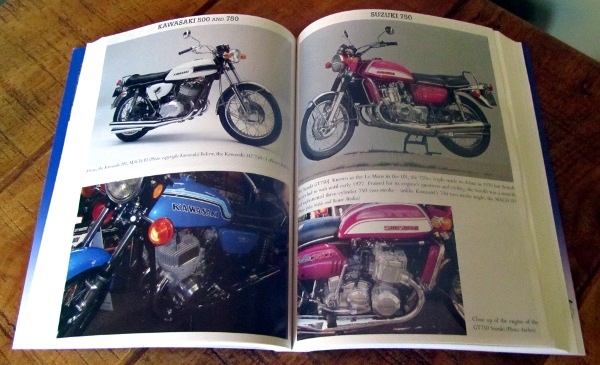SuperBikes and the 70s by Dave Sheehan
Motorcycle book, reviewed by John Newman
John Newman
In the latest issue of Dealer News, the monthly magazine for the motorcycle trade, their regular and often controversial columnist Danny DeFazio argues a case for dealers to be more imaginative in how they present their displays; and proposes that the attention grabbers in dealers windows should be those bikes that riders now in their 40's and 50's grew up with.
We're talking about RD350 Yamahas, Kawasaki KH500's and Z1's, Honda CB750's and CBX, Suzuki GT500, 750 and GS1000...you get the picture.
Dealer News dropped through the door just as I was reviewing a new book from Panther Publishing 'SuperBikes and the 70's' written by Dave Sheehan. He's a freelance writer and illustrator and lifelong bike enthusiast whose work has appeared in classic bike magazines and in comics, as well as more 'serious' publications.
The great leap forward
Borrowing from Mao and the Chinese Communist Party doctrine from the late 50's it could have been sub-titled 'The great leap forward': such was the revolutionary nature of motorcycle development in this period, and it certainly brought more joy and excitement to people's lives than Mao's cruel and failed socio/economic experiment.
Most of the new and revolutionary ideas emanated from Japan. Not all were commercially successful, for example the foray that Suzuki made into rotary engines with the RE5, and Norton's efforts to emulate former racing and sales success with their rotary machines. But largely this period provided consumers, racers and enthusiasts with new engine technologies and performance that lent credibility to the label Superbike.
Survival of the fittest
Central to the story of this decade is the struggle to survive and then the demise of the remnants of the UK motorcycle industry; focussed on BSA and Triumph, and the Norton models based around the Commando. This has been comprehensively analysed and written about elsewhere, but Dave Sheehan rightly devotes chunks of the book to this story. Including the financial and political machinations involved in trying to move a company forward in an increasingly competitive market with outdated production facilities.
He also covers the workers attempts to save their factories and their livelihoods. They were victims of the short term and blinkered profit focus which bedevilled the British motorcycle industry post Second World War. Meanwhile global economic renewal enabled Japanese companies to innovate with new production line technology.
But it is easy to forget in this period that BSA, Triumph and Norton were still able to export bikes to faithful consumers in the USA and Canada who cherished the Bonneville, and the early Triples despite the design and engineering problems that caused financial losses. Now of course the present day Triumph company has made the three cylinder engine configuration its own, providing exceptionally smooth and powerful units for its model ranges.
Digging out the facts
If it wasn't for the work and research (four years I'm told) that people like Dave Sheehan spend in digging out the facts, of the period, many aspects of our motorcycling history would be lost. It's also easy to forget that BSA, Triumph and Norton were dominant on race circuits in the USA, both flat track and Daytona. Triumph's chief executive encouraged racing, coining the marketing slogan 'Win on Sunday Sell on Monday'. Hence they were able to lead the race track charge with Triumph T100's and T150 750 Triples, and BSA with their A75 Triple.
In Europe too Percy Tait took a 500cc Triumph twin to second place in the Belgian Grand Prix: second only to Giacomo Agostini's MV. And John Hartle, Malcolm Uphill and Rod Gould were able to win and ride very fast lap times at the Isle of Man TT.
This all took place against increasing inroads into the very important US market by Honda and the other Japanese companies. Honda's first Superbike to be introduced to the world in 1970 was the CB750. Like all new machines subjected to mass line production, it wasn't without its problems, but in terms of specification its appeal to the motorcycle buyer, especially in the US, was that it was a superior product. It had both electric and kick start, disc brakes, mirrors and indicators as standard and a four cylinder alloy motor, pushing out a claimed 67bhp. Compare this to the 59bhp of the Brit Triples still equipped with drum brakes, relying on kick start only...and the purchaser would need to stump up more for fitting mirrors and indicators.
Excitement and imagination
Sheehan's book doesn't just describe the chronology of the introduction of successive models in this Superbike decade, but has gathered detailed information on all the technical and engineering production aspects of how these bikes were conceived and brought into production. Reading how this evolved, it becomes easy to understand how their concepts and design innovations captured the excitement and imagination of riders.
Bikes that we now view at shows as classics were 'bread and butter' marvels within the purchasing reach of working people. Kawasaki produced their series of very fast triples that scared many road riders and racers. Starting with the Mach 1 and 11 (250 and 350 respectively) they then brought to market the Mach 111 500cc: 'the worlds fastest accelerating stock motorcycle'. It was capable of 0-60mph in less than six seconds, topped out at around 125mph, and was nicknamed the widow maker because of its wayward if not downright dangerous handling.
Following one of these on the track, snaking wildly through Paddock Hill Bend at Brands Hatch, it was easy to see how the nickname came about. The problem stemmed from poor frame design - it was based on the inadequate frame from the 250cc model – and it is just one example of how, despite popular myth, the technological path of Japanese motorcycle production and subsequent dominance was far from smooth.
Two wheeled marvels of the day
The book takes us through the development and launch marketing of the two wheeled marvels of the day such as Suzuki's T500 and GT 750 two strokes and then towards the end of the decade, the GS1000 and Yamaha's XS750 shaft drive triple. The Kawasaki Z1 four cylinder 1000cc four stroke was a successor to the manic two strokes followed by a 750cc Mach lV, very scary: plus Honda's Gold Wing and CBX six cylinder 1000cc. The book doesn't neglect the role that Harley Davidson bikes played in this period, rivalling bikes from the UK and Japan.
So important was the demand for bigger more powerful bikes in the USA, that Dave Sheehan cites this as one reason for the development of the Superbike and the quest for more and more power. Illustrated by the regular speed and performance comparison tests carried out by the influential US bike mags, and the 'competitive' types of comparison tests we still see today in UK motorcycle magazines.
Ducati enter the fray
Having eyed the success of the Japanese factories from Europe, Ducati's chief engineer, Fabio Taglioni, and the Ducati factory decided to enter the fray and go racing with the V twin engined 750 GT. They engaged the British racer Paul Smart to help them develop and then race the bike, and in the telling of this episode the book unfolds another fascinating chapter of motorcycle development from the era which will echo with modern fans of the revered engine.
Cast your mind back...
Including an index and specifications 'SuperBikes and the 70's' gives the reader 320 pages of extremely well researched recent history of the machines many people grew up with. Not only are we given insights into a wealth of (understandable) technical detail, but Dave Sheehan also writes about the social, political and cultural aspects of the era.
How else would we find out that in 1948 the price of a Vincent Black Shadow at £381, cost 106% of the average workers annual salary. But in 1972 the purchase of high speed and excitement in the form of a Kawasaki Z1 would fall to just 60.6%. A reminder that in 1975 the massive oil price increases across the world as a result of geo political forces beyond our control would boost bike sales for a while. Also in 1975, a report from The Boston Consulting Group commissioned by the then Labour government, put the final nails into the UK bike industry coffin by attributing the demise of the industry in the decades before to 'a concern for short term profitability'. Among other things they pointed to ageing plant and labour intensive manufacturing that was unable to build to the quality and tolerances required; and a lack of investment, comparing Honda's £5K and 350 motorcycles per man per year at Suzuka, to the ageing Wolverhampton factory's £1,300 per year and 18 bikes.
This is an almost indispensable and accessible book for anyone interested in recent motorcycle history. Available from Panther Publishing
www.panther-publishing.co.uk at £19.95 – they have other tempting titles on the website too.
Any comments or books to recommend let us know at:
[email protected]




